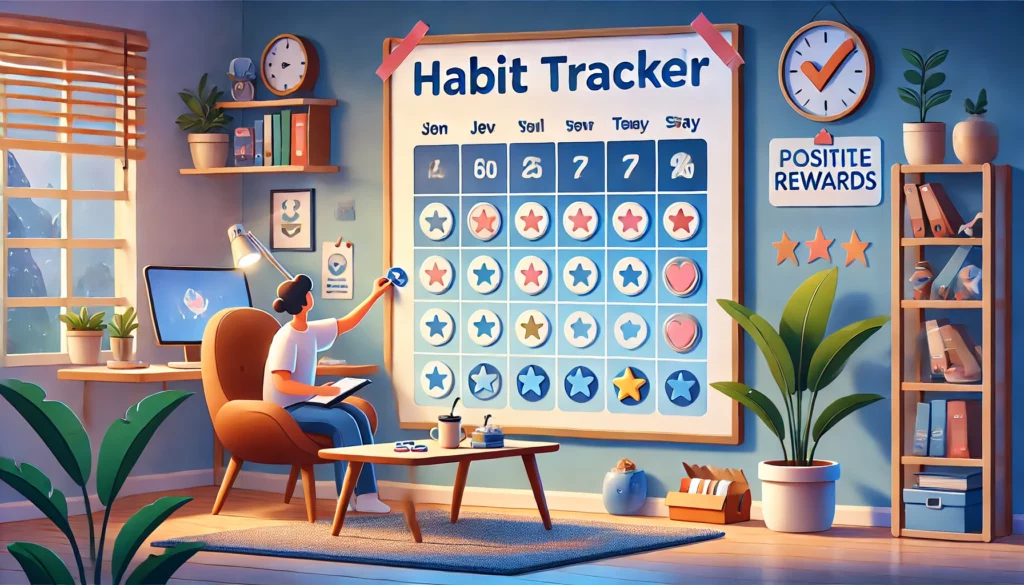One of the biggest reasons people struggle to stick with new habits isn’t lack of discipline—it’s lack of reinforcement. When there’s no reward, the brain doesn’t get the feedback it needs to lock in the behavior. On the other hand, when habits are followed by something enjoyable, your brain learns to crave the routine.
Whether you’re trying to exercise more, write every day, or spend less time on your phone, rewards are a powerful way to help habits stick. In this guide, you’ll learn how to use rewards effectively to build habits that last.
1. Why Rewards Strengthen Habits
Every habit follows a basic structure called the habit loop:
| Stage | Description | Example |
|---|---|---|
| Cue | Trigger that initiates the habit | Seeing your running shoes by the door |
| Routine | The behavior or action | Going for a jog |
| Reward | The benefit or feeling afterward | Enjoying a smoothie post-run |
Without a reward, the habit loop is incomplete. Your brain doesn’t register the behavior as worth repeating. But when a reward follows a habit, your brain makes a connection—this feels good, let’s do it again.
2. Choose the Right Type of Reward
Not all rewards are equal. The most effective ones are timely, meaningful, and support your goal.
| Type of Reward | Examples | Best Used When… |
|---|---|---|
| Intrinsic | Feeling of pride, confidence, clarity | Building long-term, identity-based habits |
| Tangible | A treat, small purchase, relaxing break | Needing short-term motivation boosts |
| Social | Sharing progress, praise, recognition | Accountability helps reinforce behavior |
Ideally, combine these for maximum impact: something that feels good now and aligns with your bigger goals.
3. Make Rewards Immediate
The brain loves instant gratification. The quicker the reward comes after the habit, the stronger the association.
Examples of immediate rewards:
- Drink a smoothie right after a workout
- Watch an episode of your favorite show after writing 500 words
- Enjoy a cup of coffee after your morning meditation
Less effective rewards:
- Promising yourself a vacation in 6 months for exercising daily (too far away)
- Rewarding progress with unhealthy behavior (like junk food after the gym)
The faster and more aligned the reward is, the better it works.
4. Use Habit Tracking as Its Own Reward
Sometimes, the best reward is simply seeing progress. Visual tracking triggers a small dopamine hit each time you complete a habit—and that can be enough.
| Tracking Method | How It Works |
|---|---|
| Calendar “X” method | Mark each completed day to create a streak |
| Habit-tracking apps | Gamify progress (e.g., Habitica, Loop) |
| Bullet journal | Write down daily wins and reflect weekly |
The satisfaction of not breaking the chain can be more powerful than a treat.
5. Try Temptation Bundling
Temptation bundling pairs something you should do with something you already enjoy. This technique makes habits more appealing from the start.
| Good Habit | Bundled Reward |
|---|---|
| Exercising | Listen to your favorite podcast |
| Folding laundry | Watch Netflix while doing it |
| Studying or reading | Sip your favorite smoothie or tea |
You’ll start looking forward to the habit because it’s paired with something rewarding.
6. Use Social Rewards and Accountability
Sometimes, simply telling others about your progress—or hearing their encouragement—is more powerful than a physical reward.
Ways to use social accountability as a reward:
- Post daily updates on your habit progress
- Join a habit-building challenge or community
- Celebrate milestones with a friend or coach
Social support makes the process more engaging, especially if you thrive on recognition or group motivation.
7. Upgrade Rewards as Habits Grow
What feels rewarding at the beginning might not motivate you later. As habits become routine, your rewards should evolve.
| Habit Stage | Beginner Reward | Advanced Reward |
|---|---|---|
| Reading daily | 10 minutes of YouTube after reading | Buy a new book after finishing 5 |
| Exercising consistently | Smoothie after workouts | New workout gear after a month |
| Writing every day | Watch a video after writing | Take a writing retreat after 30 days |
Think of your reward system as a staircase. The more consistent you are, the better the reward at each step.
8. Avoid Rewards That Sabotage Progress
Some rewards feel good in the moment but undermine your long-term goals. These “trap rewards” can turn your habit into a cycle of self-sabotage.
Examples of counterproductive rewards:
- Eating junk food as a reward for healthy eating
- Spending money after reaching a savings goal
- Skipping your next task as a reward for being productive
Instead, ask: Does this reward reinforce my identity and goals?
9. Customize Your Reward System
The best reward system is one you’ll actually use. There’s no one-size-fits-all method, so experiment to see what sticks.
Ask yourself:
- Do I enjoy private rewards (journaling, treats) or social ones (sharing progress)?
- Do I need daily reinforcement or is a weekly milestone enough?
- Do I prefer digital tracking or something physical like a journal or sticker chart?
Your preferences matter—this is about what motivates you, not what works for someone else.
10. Celebrate Milestones to Keep Momentum
Milestones are natural breaking points where many people quit—or double down. If you don’t recognize progress, motivation can stall. Celebrating even small wins makes the habit-building process satisfying.
Examples of milestone rewards:
- Complete 30 days of workouts → Buy a new yoga mat or running shoes
- Meditate every morning for a month → Enjoy a massage or spa day
- Hit a savings goal → Treat yourself to a guilt-free dinner out
The habit becomes something to look forward to—not just something to “get through.”
Final Thought: Rewards Aren’t Bribes—They’re Tools
Too often, people think using rewards means they’re not disciplined enough. That’s simply not true. Rewards are part of the psychology of behavior change. When used properly, they support consistency, increase satisfaction, and make habits something you want to stick with.
So instead of relying on willpower alone, build a system where your good habits are enjoyable. Choose rewards that reinforce who you’re becoming—and soon those habits will feel less like effort, and more like second nature.
Gabriel Silva is the founder of Cursos e Soluções, a blog dedicated to personal growth, habit change, and self-discipline. Passionate about self-development and productivity, he shares practical, research-backed strategies to help people achieve their goals. He believes that small, consistent changes can lead to significant transformations over time and is committed to providing content that empowers both personal and professional success.







